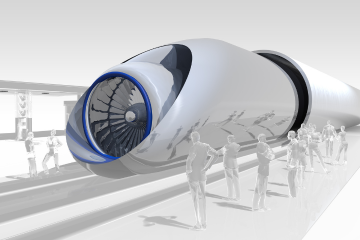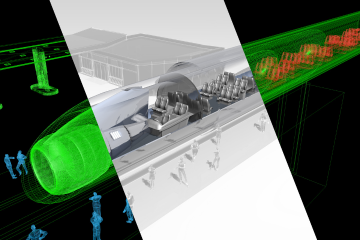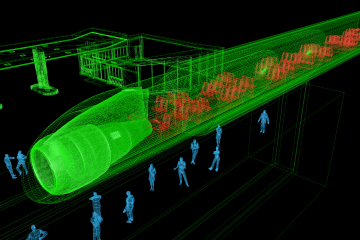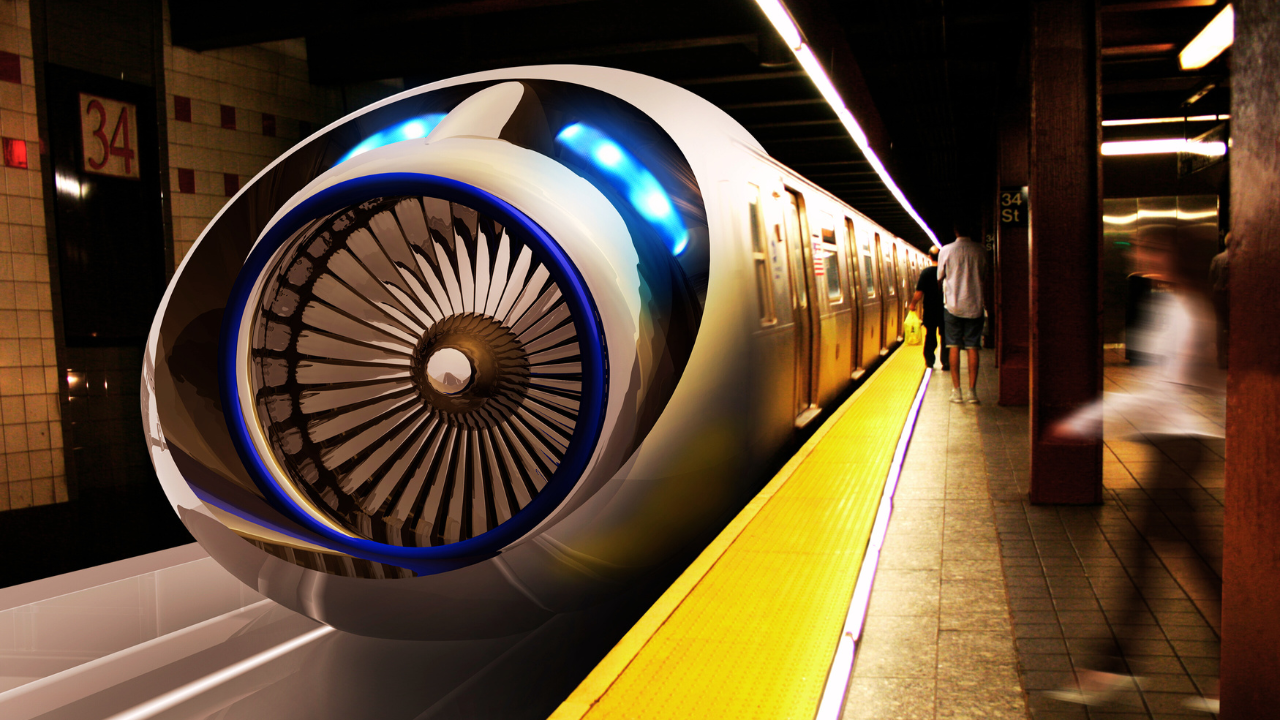Hyperloop Technology : A Look inside at How it works, Benefits, Cost effect and Safety systems
Introduction to Hyperloop Technology
Hyperloop is a new transportation concept that promises to revolutionize travel with the introduction of high-speed passenger and cargo pods accelerated through low-pressure tubes. Originating from Tesla and SpaceX CEO Elon Musk back in 2013, Hyperloop aims to utilize innovative technologies like electromagnetic propulsion and levitation to achieve airplane speeds at ground level.
So what exactly is Hyperloop? It is essentially an enclosed tube system through which pods or capsules travel seamlessly from one destination station to another at speeds reaching 640+ mph. This transportation portal of the future uses electric propulsion motors, powerful batteries, magnetic levitation, and other advanced technologies to zoom passengers and cargo in floating pods to their destinations.
The low-pressure environment created within the tubes combined with magnetic levitation allows the pods to operate almost frictionless. This creates the possibility for tremendous efficiencies in speed, energy use, and capacity compared to traditional modes of transportation like rail, air, or road vehicles. And it provides all this in a fully-enclosed and weather-proof system that could traverse over or underground in various terrain.
While still a emerging new concept requiring extensive testing, Hyperloop systems are now quickly moving from rough designs on paper towards full-scale working prototypes and commercialization. It represents one of the most exciting technological revolutions currently happening in sustainable mobility. Many countries have taken keen interest due its potential to vastly shrink travel times, energy consumption, costs, and environmental impact.
What Makes Hyperloop Different?

So what sets this novel Hyperloop transportation model apart from existing forms of travel? The two most similar alternatives would be high-speed rail lines and conventional air travel routes which also focus on rapid long distance passenger and freight transport.
Hyperloop differentiates itself in some key ways:
- Speed: Hyperloop pods are projected to reach peak speeds of 640 mph or more. At max speed, they could complete a 550 mile trip in under 1 hour. This is 2-3 times faster than high-speed trains and competes with air travel minus wait times.
- Efficiency: The electric motors accelerate pods using a fraction of the energy required for a similar sized airplane. And solar panels integrated along route can directly supply clean renewable energy.
- Enclosure: Hyperloop tubes fully protect against all weather conditions ensuring reliable operation in rain, snow, storms, or other natural events that frequently disrupt airports and open-air rail.
- Autonomy: With automated self-driving pods running as frequently as every 20-40 seconds, Hyperloop aims for minimal stops and maximal system uptime to keep people and goods flowing seamlessly.
In many ways, Hyperloop combines the main advantages of trains, planes, self-driving vehicles and green energy into one integrated system for the 21st century and beyond.
Benefits of Hyperloop
A full-scale Hyperloop system linking cities and regions would provide enormous advantages over current transportation infrastructure in areas like:
Speed
- Complete long regional journeys of hundreds of miles in under an hour. For context, a 550 mile trip would take just under 1 hour versus 11+ hours by car.
Cost Efficiency
- Projected passenger ticket prices could be lower than air travel and significantly cheaper than high-speed rail. Operational costs are lowered by electric versus jet propulsion.
Energy Efficiency
- Hyperloop’s fully electric motors use a fraction the energy per person compared to airplanes. Solar panel integration directly supplies clean renewable energy to the system.
All-Weather Reliability
- Enclosed tubes provide protection from rain, snow, wind, storms and other external hazards that routinely delay travel on roads, rails and runways.
Enhanced Safety
- The enclosed and grade-separated tubes prevent virtually any collisions, while integrated automation and sensors give precision control.
Mass Transport Scale
- With small pods departing every 20-40 seconds carrying up to 20-30 passengers, the cumulative transport capacity will be incredibly high allowing movement of tens of thousands per hour.
Sustainability
- Beyond high energy efficiency, right-of-way smart routing of tubes further reduces environmental impact by avoiding communities and sensitive habitats.
The combination of maximized speed and efficiency with weather-proof reliability, high safety, and mass throughput provides society an exceptionally advanced mobility solution for the 21st century. It brings together the convenience of air travel with the environmental sustainability of high-speed rail and then exceeds both.
How the Hyperloop System Works

So how exactly does this futuristic tube-based transport network operate? The Hyperloop concept leverages several advanced engineering systems to allow pods to zip passengers and cargo at unprecedented speeds and efficiency.
Electromagnetic Propulsion
Linear electric motors placed at set intervals along the low-pressure tubes are able to accelerate pods at high rates of g-force allowing them to reach speeds of 640+ mph in very short mid to long-range distances. These linear accelerators supply tremendous instantaneous kinetic energy with far greater energy efficiency than gas combustion engines.
Magnetic Levitation
Once the electric motors have propelled the pod to cruising speed, magnetic levitation technology is used to keep the pod floating on a cushion of air and prevents any contact with the ground or tube walls. This magnetic levitation or “mag-lev” system minimizes friction allowing incredible speeds to be maintained.
Low-Pressure Environment
The tubes are kept at partial vacuum pressure levels to maximize aerodynamic movement. At about 1/6th normal atmospheric conditions, there is so little air friction acting on pod walls that they can narrowly slice through the tubes at unprecedented velocities.
By combining these advanced propulsion, levitation, and aerodynamics principles within an fully weather-proof infrastructure, the Hyperloop concept discovers how to push human mobility into new realms. The science is based on well-understood technologies engineered into an integrated transportation machine.
Basic Principles of Hyperloop
If we break down a Hyperloop system to its core building blocks, these are the main components that enable the technology:
Pods
Lightweight pods or capsules crafted from aluminum or composites carry passengers, goods, and vehicles on demand. They offer comfortable g-balanced ride and safety despite the high speeds. Private cabins give people and goods “plane like” experiences, while larger car carrying models transition vehicles long distances.
Tubes
Low-pressurized tubes elevated on pylons or buried underground provide the frictionless pathways for pods to conserve energy at high velocities. Durable steel and concrete maintains vacuum seal despite environmental stresses and hazards over long routes.
Motors
Powerful electric motors positioned at the end stations and at regular intervals provide initial and boost acceleration. Electromagnetism generates ultra-responsive propulsion that keeps pods moving swiftly nonstop end-to-end.
Batteries
Large battery banks feed reliable excess power for half the route and back up the solar arrays. Long-lasting lithium ion clusters handle pulse demands from pods for the highest anticipated daily volumes.
Solar Panels
Dual solar panel rows mount atop tube pylons and supply between 50%-100% daytime electrical needs eliminating external grid reliance. Mass arrays scale up limitless clean energy as tube networks expand.
The streamlined integration of these exponentially improving technologies is what enables Hyperloop to overcome the speed and energy limits of older mobility vehicles.
How Hyperloop Differs from High-Speed Trains
While the Hyperloop concept borrows certain principles from high-speed rail, it is an entirely novel transport category that surpasses the inherent limits of traditional trains. Some key differences include:
- Enclosed Tube Infrastructure
Hyperloop features fully weather-proof and controlled tube environments for pod travel versus open-air rails exposed to elements. This avoids weather delays and provides opportunities to optimize pod speeds/energy use that trains cannot match.
- Levitation and Propulsion
Trains rely on steel wheel friction and locomotives pulling heavy loads using combustion engines. Hyperloop instead uses magnetic and air levitation for near frictionless movement allowing much faster acceleration via pure electric linear motors.
- Autonomy
High-speed trains still have onboard engineers, drivers and conductors. Hyperloop systems operate fully autonomously with AI controlling rapid nonstop pod departures every 20-40 seconds. No staffing is needed along routes.
- Energy Efficiency
Even the most advanced bullet trains cannot compete with the projected passenger mile energy efficiency of Hyperloop systems. Partially due to electric versus diesel motors and low tube environment drag.
While rail travel has served society well for over a century, the Hyperloop concept takes transportation technology into territories that finally leave old mobility limits behind. It encapsulates the digital revolution principles now changing other industries to rethink long distance connectivity.
Costs to Build Hyperloop
A frequent question regarding this new transportation mode is how much does it cost to construct Hyperloop networks? As an emerging new infrastructure, estimates still vary widely based on different vendor approaches and route types. However, some general cost insights include:
- Per Mile Costs
Projected Hyperloop tube construction costs range from $20 million per mile on the low end to $121 million per mile on the high end, with averages around $40-$50 million per mile. Compare this to California High Speed Rail projects projected around $167 million per mile.
- Scale Benefits
Like any new technology, costs are higher in early stages and expected to come down with operational experience and scale. Building longer routes of hundreds of miles will significantly reduce per mile expenses through improved efficiency.
- Geography Optimization
Another cost reduction will come from smart geographical routing and tube design tailored to each route’s terrain. Hyperloop can utilize straighter paths avoiding populous areas which is costlier for highways and railroads. Underground tunneling where required also limits right-of-way issues.
- Regulatory Hurdles
New transport modes require certification and compliance with safety and environmental regulations. Navigating the bureaucracy and permitting processes adds financial burden. technology validation and policymaker education is still required.
While Hyperloop timelines and capabilities make it highly attractive over other mobility modes, reducing the costs to build and certify these new sustainable networks remains imperative for widespread adoption around the world.
Progress and Testing of Hyperloops

How far along are Hyperloops from being ready for full public deployment? Several leading companies in this space have advanced quickly in recent years from early design concepts to now having working prototypes in the field.
Some major progress milestones include:
- Hyperloop Transportation Technologies successfully tested a full-scale passenger capsule in 2019, demonstrating the levitation, stability, and propulsion dynamics at speeds over 200 mph.
- Virgin Hyperloop achieved manned pod tests in 2020 hitting speeds of 107 mph at their full-scale DevLoop test track in Las Vegas. The 500 meter track has enabled rapid validation of pod integration with motor and maglev systems.
- In 2021, Virgin Hyperloop at the similarly scaled test facility in West Virginia carried passengers for the first time reaching speeds up to 240 mph in just seconds. The facility proves G-force safety and allows observing passenger experience in enclosed low pressure environments.
- Transpod, a Hyperloop company based in Toronto, is on track to debut a 3.6 mile test track in France called the Limoges facility in 2025. This would become the world’s longest test track and further stress test larger system dynamics.
While still heavily focused on safety validation and concept refinement through these test tracks, the rapid advances towards demonstrating technical viability, passenger experience viability, and being on the cusp of commercial viability indicates how quickly the Hyperloop mode could potentially transform mobility this decade.
Future Hyperloop Route Planning
Assuming the technology successfully proves itself out, where exactly could we see Hyperloop routes enabling rapid regional transport? Several locations have emerged as prime candidates for the first working commercial lines.
- United States
Proposed Hyperloop tracks are being explored in Texas between Austin, Houston and San Antonio. Colorado also proposed a line connecting Denver to Colorado Springs and Pueblo. The Midwest could see a route spanning Missouri, Illinois and Ohio.
- International
India has strongly embraced Hyperloop technology with a proposed route between Mumbai and Chennai. Abu Dhabi plans an ultra-high speed line to Dubai crossing the entire United Arab Emirates. The European Commission selected a Hyper Poland consortium to develop an operational route between Poland’s capital cities.
Other countries like Mexico, Indonesia, Thailand, Ukraine, Spain and the UK also have feasibility studies underway for potential nationwide Hyperloop infrastructure connecting urban hubs.
- Route Types
The routes being researched reflect two models. The first are dense megacity connections like New York to Washington D.C that would ease commuter traffic along heavily congested corridors. The second are long distance links between city pairs separated by 500-1000 kilometers enabling rapid transit between regions positioning Hyperloop as an intercity replacement for short haul flights.
The flexibility to enhance mobility across both dense urban zones and broader countrywide regions demonstrates the versatility of Hyperloops. Nations around the globe clearly recognize their potential as world-leading transportation networks for the future sustainable economy.
When Will Hyperloop Be Operational?
With prototypes now showcasing the unique high-speed capabilities using passenger pods on test tracks, attention is turning to the timeline for putting full-fledged systems into commercial operation.
So what are the major steps and milestones towards seeing a working intercity line serving the public?
- Safety Certification
Ensuring utmost safety assurance is critical before routinely moving people at 600+ mph in low pressure tubes. Hyperloop companies must continue extensive testing hand-in-hand with regional authorities to finalize safety protocols.
- Infrastructure Build Out
Full route construction requires large civil projects spanning dozens to hundreds of miles across terrain. Land surveys, pylon installation, tunneling, and tube integration represents multi-billion investments per route.
- Economic Viability
A business model realizing profitable operations must materialize through ridership revenue, cargo partnerships, licensing, and other funding channels to sustain growth. Government sponsorship can supplement long term vision of societal benefits.
- Early Operational Lines
The consensus expectation based on the current pace of technology validation isseeing the first passenger-ready Hyperloop systems perhaps operating by 2030,most likely beginning as demonstration cases on shorter routes of 15-30 miles.
As systems expand privately and across countries this decade, Hyperloop by 2040 could grow into a bustling high-speed back bone for regional and even national transportation ecosystems. The 100 year old gap between aviation’s emergence to commercial route maturation could happen within 10-20 years for air-travel-alternative tube transportation.
Hyperloop Passenger Ticket and Cargo Rates
A transportation model lives or dies based on whether customers can access services at attractive prices. Given the major infrastructure investments required, what could pricing look like for passengers and cargo on future Hyperloop networks?
- Passenger Ticket Prices
Aim to price just below or on par with airline ticket prices for similar distance routes to attract ridership. Some projections estimate ~$60 for a 15 minute, 100 mile trip. ~$120-$150 for a 30 minute 300 mile regional journey. And ~$200-$250 for a 45 minute 550 mile route competing with short haul flights.
- Cargo Rates
For freight transportation, a Hyperloop pod filled with cargo containers able to rapidly deliver goods 500+ miles could charge premium delivery prices. However, the higher max throughput of tube infrastructure makes each unit costs affordable. Estimates suggest ~60% savings over truck costs for regional freight delivery allowing rapid same day e-commerce.
- Cost Declines
As with any new technology, costs are highest early on and will benefit from scale efficiencies. Passenger and cargo prices should fall over time further accelerating Hyperloop adoption and making it accessible across income levels.
- New Revenue Models
Various business models also allow recouping funds beyond direct usage fees. These include licensing proprietary technologies to foreign governments developing their own Hyperloop networks as well as capitalizing new real estate opportunities around station hubs.
Hyperloop Safety Concerns and Failsafe Systems
Individuals understandably want to know how safe the prospect could be of traveling in a tunneled pod at near airliner speeds. However, given no fundamental technical barriers have surfaced after nearly a decade since conception, Hyperloop could ultimately become one of the safest modes ever engineered for mass transportation.
Here are some of the major provisions to ensure failsafe protections:
- Redundant Power and Communication
Hyperloop tubes have fully redundant power and communications running simultaneously. Any loss to the primary system leads to instantaneous hot switchover to backups without service disruption.
- Escape and Evacuation
Pods have emergency exits to swiftly evacuate all riders even in remote areas. Straight tube paths with few end stations allows easy full route access. Escape paths guide passengers to safety in any contingency.
- Earthquake and Storm Resilience
Seismic modeling informs tunnel and pylon construction able to withstand substantial earthquakes. Sensors also enable pods to rapid decelerate if unexpected shaking is detected. Exterior hazards like storms minimally impact interior tubes.
- Automated Controls
With AI controlling acceleration, cruising, pod spacing, and braking, human error risk is largely eliminated which causes over 90% of transportation accidents. Precision machine performance far surpasses human driver capabilities.
By harnessing technological advances like computing, sensor instrumentation, and material sciences, the integrated Hyperloop system may ultimately deliver unprecedented levels of control, redundancy, and resilience that sets the benchmark for mobility safety for the next century and beyond.
Sustainability Benefits of a Hyperloop Network
Beyond the direct economic and performance advantages of a new high-speed transportation option, Hyperloop technology also promises enormous environmental sustainability benefits that will help society achieve critical decarbonization goals.
- Energy Efficiency
The fully electric motors accelerating pods are projected to use just 1/10th the energy per passenger mile compared to an airplane. Further solar panel integration directly supplies clean renewable energy helping achieve net-zero carbon operation.
- Clean Manufacturing
Hyperloop companies also take sustainability seriously in the design and build process. Virgin Hyperloop partnered with Bamboo Engineers to realize pods made almost entirely of bamboo composites – a rapidly renewable material that absorbs more CO2 than emitted during production.
- Right-of-Way Routing
Constructing elevated pylons and tunnels enables straight line point-to-point connections avoiding wildlife areas and low-impact pathways compared to infrastructure like highways and railways that fragment sensitive ecosystems.
- Economic Growth Engine
The emergence of Hyperloop networks will create enormous innovation and high-tech job opportunities. Environmentally conscious mobility models boost quality lifestyle access while unlocking billions in new economic output.
Hyperloop technology reflects the confluence of digital systems, sustainable manufacturing, and renewable energy that characterizes solutions harnessing tech to usher environmentally harmonious living. It provides a model for meeting society’s mobility needs while respecting planetary boundaries.
Conclusion
In conclusion, private collaborations utilizing state-of-the-art research are propelling Hyperloop technology forward from a theoretical notion into early real-world deployment. A new class of transportation with the environmental efficiency of high-speed rail and the ability to connect regional city pairs at previously unheard-of speeds comparable to aviation is promised by the innovative integration of levitation, electrification, and autonomy.
There is a great deal of optimism that the 2020s will see the launch of this new sustainable mobility solution on commercial routes, since multiple Hyperloop test track locations have already shown their technological capabilities with full-scale pods and linear motor propulsion systems. In order to guarantee failsafe reliability on par with airplanes, safety validation is progressing concurrently.
Governments and businesses around the world are excited about creating Hyperloop infrastructure that will improve travel, economy, and accessibility for next smart cities while maintaining environmental responsibility. Long-term options include anything from rearranging commutes to short-haul airline replacements to eventually building massive national complexes that redefine contemporary transportation.
